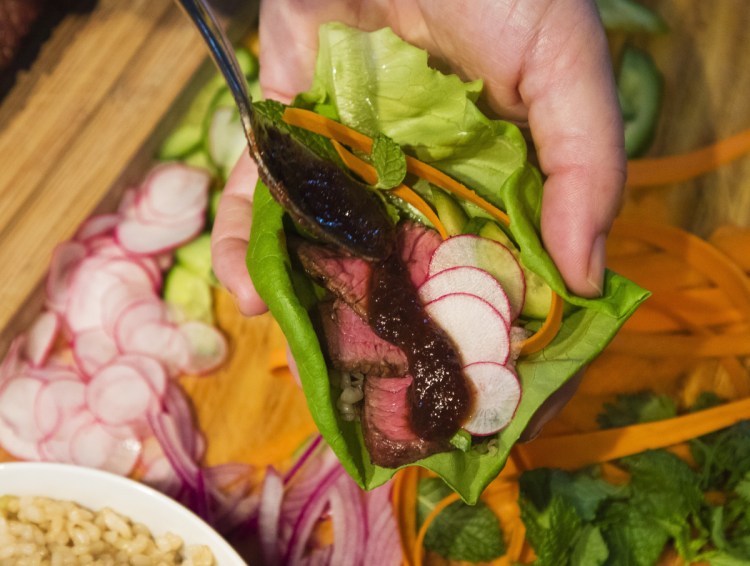There is more than one way to marinate a piece of protein before throwing it onto the grill. Managing that process helps environmentally friendly cooks avoid pouring pints of used, or maybe more appropriately, misused marinade down the drain. Before you go getting all grossed out by the thought of serving a liquid previously used to bathe a raw piece of meat, keep reading.
The first step in decreasing the amount of marinade potentially wasted, is to start off using as little marinade as will still do its job. To do that, place any meat to be marinated in as small a non-reactive container as it will fit into. When you tightly squeeze a 2 pound, top-round steak into a 7-by 10-inch baking dish, it will require less marinade to seep into every corner of the dish and flavor the entire surface area of the meat than if you put it in an oversized dish.

Christine Burns Rudalevide pours the ketjap marinade into a saucepan. Reduced, it will serve as a sauce for the filling in the lettuce wraps.
Yes, for food safety reasons, you can’t just pour used marinade into a gravy boat and call it sauce. Like your grandmother warned you, the raw meat that went on to be cooked very likely left behind some harmful bacteria in the marinade. However, you can safely serve it if you bring the used marinade to a boil and keep it rolling there for five minutes. What I call “The Boil” typically works best for soy-based marinades used for beef and lamb. These typically have a sweet element – like brown sugar or maple syrup (see recipe) – and not a lot of oil. The boiling process reduces the final product to a thicker glaze that gets drizzled over the cooked meat, used to flavor a noodle dish or stirred into broth for a makeshift pho.
These boiled-down glazes are no longer effective marinades, though, as the alkalinity of the meat leached into the liquid when they sat together overnight, so the acidity of the overall mixture lessons. Less acid means it will no longer effectively make its way into the meat to flavor it.
If you can’t be bothered with The Boil, consider “The Après-Grill Soak.” This method involves seasoning the meat (or vegetables) with salt and rubbing it with oil before throwing it on the grill. When the meat is cooked, douse it with the marinade while it’s still warm and let it sit to soak up the flavors before serving. This is the method I employ when I’ve forgotten to marinate the meat earlier in the process. The method works with any vinaigrette, homemade or bottled. Be warned, though, that the acid content of vinaigrettes are high, so if you’ve arranged some zucchini slices or broccolini spears on the grill alongside your chicken or pork, adding the vinaigrette to them while they are still warm will render them more Army and less Kelly green.

After being removed from the marinade, top-round beef steak is grilled and rested, then sliced thinly.
The “Half and Half” technique involved making one thicker marinade – like kale chimichurri or carrot top salsa verde – and using half to flavor meat shortly before it goes on the grill and serving the other half with the cooked protein. This works best with fish or chicken because they can pick up the flavor of these marinades more quickly than red meats and should these get dried out by the grilling process, the reserved marinade can help hide that fact.
The final technique, “The Cling,” denotes how the marinade adheres to the meat during both the marinating and cooking processes. Because yogurt and mayonnaise-based marinades, like an Indian tandoori marinade, readily stick to the meat, typically little is left in the bowl.
If none of these help you curb your wasted marinade habits, maybe you should run with a dry rub instead.
ABOUT THE WRITER
CHRISTINE BURNS RUDALEVIGE is a food writer, recipe developer and tester, and cooking teacher in Brunswick, and the author of “Green Plate Special,” a cookbook from Islandport based on these columns. She can be contacted at cburns1227@gmail.com.
Send questions/comments to the editors.


